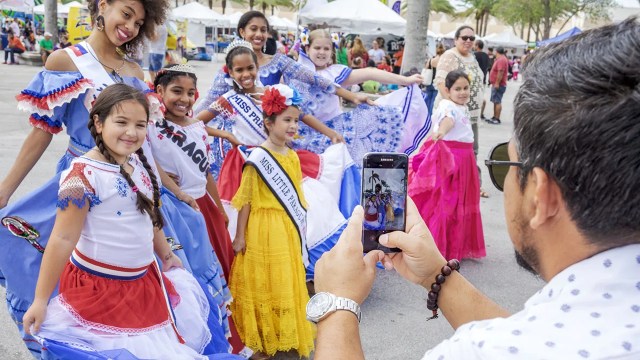
Debates over who is Hispanic and who is not have often fueled conversations about identity among Americans who trace their heritage to Latin America or Spain. Recently, results from the 2020 census have drawn attention to how Hispanic identity is defined and measured in the United States.
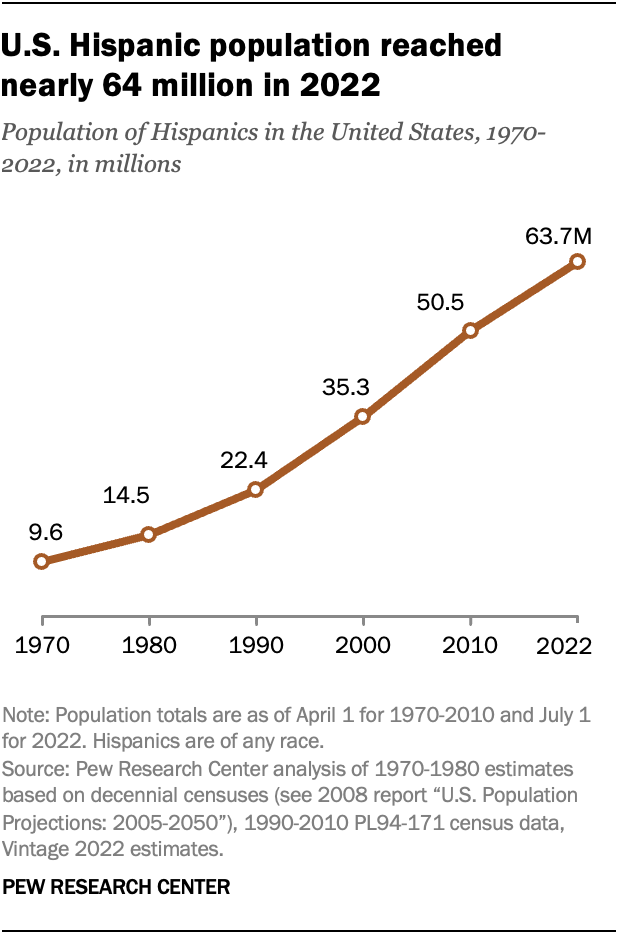
The once-a-decade head count of all people living in the U.S. used a different approach from previous censuses to measure racial identity, which has provided new insight into how Hispanics view their racial identity. At the same time, the federal government has proposed a change to how race and ethnicity are measured in government surveys like the decennial census, bringing even more attention and debate.
So, who is considered Hispanic in the U.S. today? How exactly do the federal government and others count the Hispanic population? What role does race play in deciding who counts as Hispanic? And how do surveys incorporate various terms people use to describe their Hispanic identity, such as Latina or Latinx?
We’ll answer these common questions and others here.
To answer the question of who is Hispanic, this analysis draws on five decades of U.S. Census Bureau data and two decades of Pew Research Center surveys of Hispanic adults in the United States.
National counts of the Latino population come from the Census Bureau’s decennial census (this includes PL94-171 census data) and official population estimates. The bureau’s American Community Survey (ACS) provides demographic details such as race, country of origin and intermarriage rates. Some ACS data was accessed through Integrated Public Use Microdata Series (IPUMS) from the University of Minnesota.
Views of Hispanic identity draw on the Center’s National Survey of Latinos (NSL), which is fielded in English and Spanish. Hispanics have taken the survey online since 2019, primarily through the American Trends Panel (ATP), which is recruited through national, random sampling of residential addresses. This way nearly all adults have a chance of selection. The survey is weighted to be representative of the U.S. Hispanic adult population by gender, Hispanic origin, partisan affiliation, education and other categories. Read more about the ATP’s methodology. The NSL was conducted by phone from 2002 to 2018.
Read further details on how the Census Bureau asked about race and ethnicity and coded responses in the 2020 census. Here is a full list of origin groups that were coded as Hispanic in the 2020 census.
How many Hispanics are in the U.S. today?
The Census Bureau estimates there were roughly 63.7 million Hispanics in the U.S. as of 2022, a new high. They made up 19% of the nation’s population.
Behind the official Census Bureau number, however, lies a long history of changing labels, shifting categories and revised question wording on census forms. That history reflects evolving cultural norms about what it means to be Hispanic or Latino in the U.S. today.
How are Hispanics counted in government surveys, public opinion polls and other studies?
Before diving into the details, keep in mind that some surveys ask about Hispanic origin and race separately, following current Census Bureau practices:
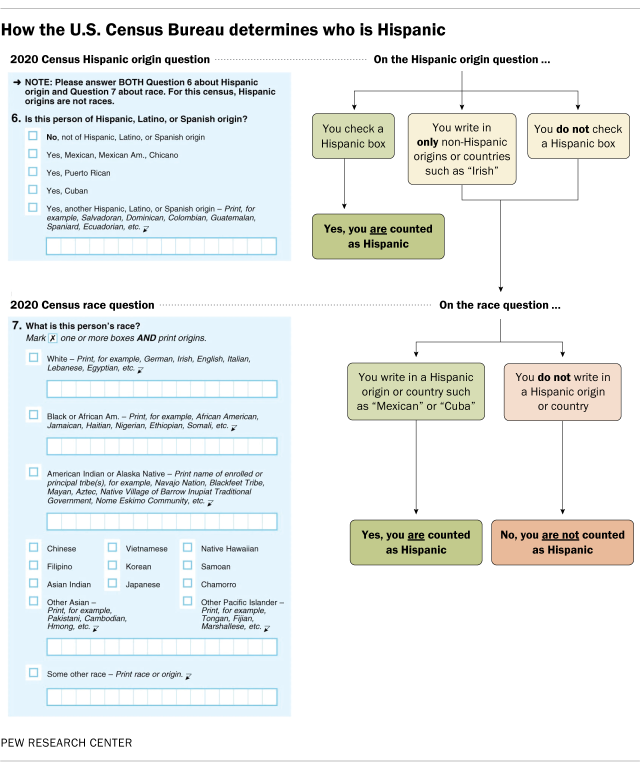
One way to count Hispanics is to include those who say they are Hispanic, with no exceptions – this is, you are Hispanic if you say you are. Pew Research Center uses this approach in our surveys, as do other polling firms such as Gallup and voter exit polls.
The Census Bureau largely counts Hispanics this way, too, but with some exceptions. If respondents select only the “Other Hispanic” category and write in only non-Hispanic responses such as “Irish,” the Census Bureau recodes the response as non-Hispanic.
However, beginning in 2020, it widened the lens to include a relatively small number of people who did not check a Hispanic box on the census form but answered the race question in a way that implied a Hispanic background. As a result, someone who wrote that their race is “Mexican” or “Argentinean” in the race question was counted as Hispanic, even if they did not check the Hispanic box.
From the available data, the exact number of respondents affected by this change is difficult to determine, but it appears to be about 1% of Hispanics or fewer.
How did Hispanics identify their race in the 2020 census?
In the eyes of the Census Bureau, Hispanics can be of any race, because “Hispanic” is an ethnicity and not a race. However, this distinction is subject to debate. A 2015 Center survey found that 17% of Hispanic adults said being Hispanic is mainly a matter of race, while 29% said it is mainly a matter of ancestry. Another 42% said it is mainly a matter of culture.

Nonetheless, the Census Bureau’s 2021 American Community Survey (ACS) provides the self-reported racial identity of Hispanics. For example, 22.1 million single-race Hispanics identified only as “some other race,” a group that mostly includes those who wrote in a Hispanic origin or nationality as their race. The next largest single-race group among Hispanics was White (10.2 million), followed by American Indian (1.4 million), Black (900,000) and Asian (300,000).
In addition, about 27.6 million Hispanics identified as more than one race in 2021, up from just 3 million in 2010. The sharp increase in multiracial Hispanics could be due to several factors, including changes to the census form that added space for written responses to the race question and growing racial diversity among Hispanics. The former explanation is supported by the fact that more than 25 million of the Hispanics who identified as two or more races in 2021 were coded as “some other race” (and wrote in a response) and one of the specific races (such as Black or White).
Growth in multiracial Hispanics comes primarily from those who identify as White and “some other race.” That population grew from 1.6 million to 23.7 million between 2010 and 2021. The number of Hispanics who identify as White and no other race declined from 26.7 million to 10.2 million.
Is there an official definition of Hispanic or Latino?
In 1976, the U.S. Congress passed a law that required the government to collect and analyze data for a specific ethnic group: “Americans of Spanish origin or descent.” That legislation defined this group as “Americans who identify themselves as being of Spanish-speaking background and trace their origin or descent from Mexico, Puerto Rico, Cuba, Central and South America, and other Spanish-speaking countries.” This includes 20 Spanish-speaking nations from Latin America and Spain itself, but not Portugal or Portuguese-speaking Brazil.
The Office of Management and Budget (OMB) developed standards for collecting data on Hispanics in 1977 and revised them in 1997. Schools, public health facilities and other government entities and agencies use these standards to track how many Hispanics they serve – the primary goal of the 1976 law.
In 2023, an OMB working group sought public feedback on a proposal to combine the race and ethnicity questions asked in federal surveys, including the decennial census. The proposal would add checkboxes for “Hispanic or Latino” and “Middle Eastern or North African.” Officials hope the changes will reduce the number of Americans who choose the “Some other race” category, especially among Hispanics.
The review of the proposal is scheduled to be completed by summer 2024. Approved changes would be implemented in the 2030 census and other Census Bureau surveys. However, it’s worth noting that public feedback has included concerns that combining the race and ethnicity questions could lead to an undercount of the nation’s Afro-Latino population.
What’s the difference between Hispanic and Latino?
“Hispanic” and “Latino” are pan-ethnic terms meant to describe – and summarize – the population of people of that ethnic background living in the U.S. In practice, the Census Bureau often uses the term “Hispanic” or “Hispanic or Latino.” We use the terms “Hispanic” and “Latino” interchangeably for this population in our work.
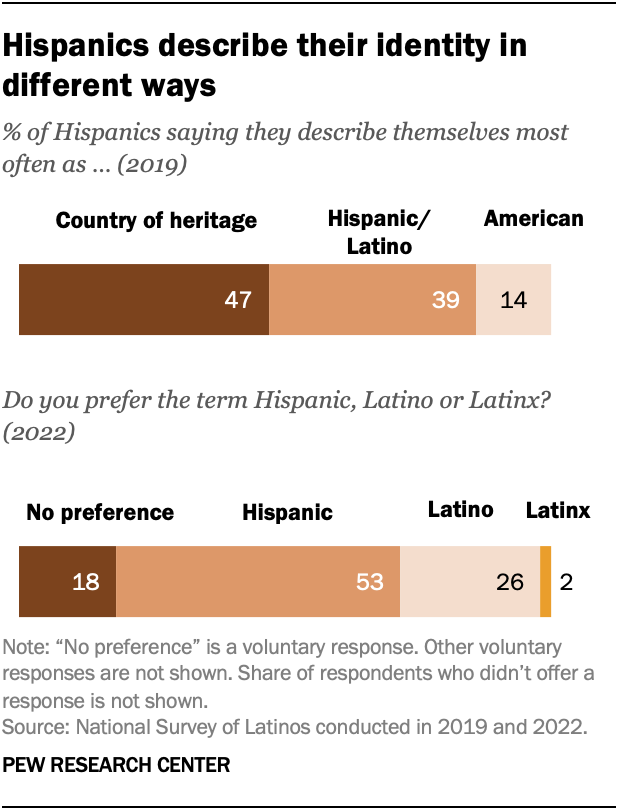
Some people have drawn sharp distinctions between these two terms. For example, some say that Hispanics are from Spain or from Spanish-speaking countries in Latin America, which matches the federal definition, and Latinos are people from Latin America regardless of language. In this definition, Latinos would include people from Brazil (where Portuguese is the official language) but not Spain or Portugal.
Despite this debate, the Hispanic and Latino labels are not universally embraced by the population that has been labeled, even as they are widely used. Our own surveys show a preference for other terms to describe identity. A 2019 survey found that 47% of Hispanics most often described themselves by their family’s country of origin, while 39% used the terms Latino or Hispanic and 14% most often described themselves as American.
Another Center survey in 2022 found that 53% of Hispanics prefer to describe themselves as “Hispanic,” 26% prefer “Latino,” 2% prefer “Latinx” and 18% have no preference.
Who uses ‘Latinx’?
Latinx is a pan-ethnic identity term that has emerged in recent years as an alternative to Hispanic and Latino. Some news and entertainment outlets, corporations, local governments and universities use it to describe the nation’s Hispanic population. Yet the use of Latinx is not common practice, and there is debate about its appropriateness in a gendered language like Spanish. Some critics say it ignores the gendered forms of Spanish language, while others see Latinx as a gender- and LGBTQ-inclusive term. Adding to this debate, some lawmakers have gone as far as introducing legislation to ban use of the term in government communication.
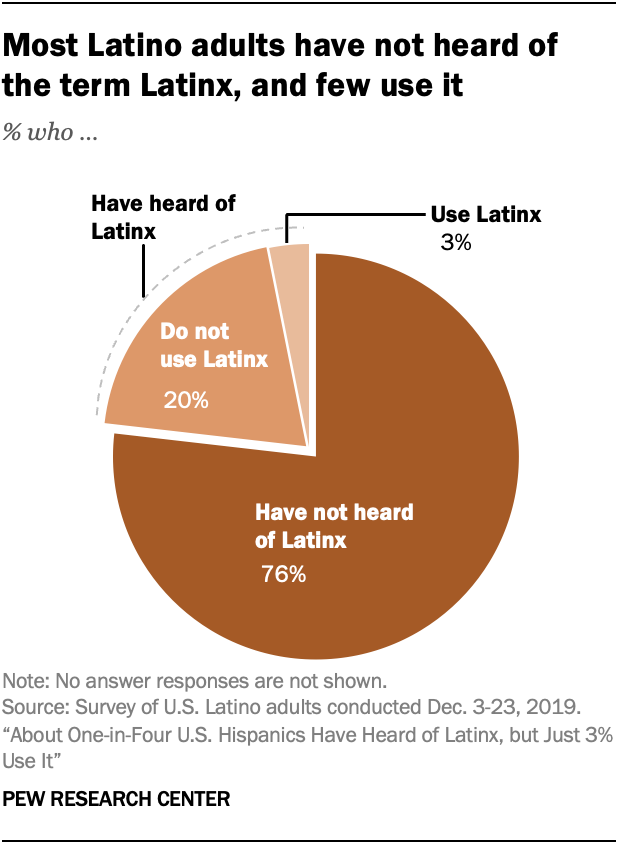
The term is not well known among the population it is meant to describe. In a 2019 Center survey, only 23% of U.S. adults who self-identified as Hispanic or Latino had heard of the term, and just 3% said they use it to describe themselves.
However, awareness and use of the term varied across subgroups of Hispanics. For example, 42% of those ages 18 to 29 said they had heard of the term, compared with 7% of those 65 and older. And among the youngest Hispanic adults, women were much more likely than men to say they use the term (14% vs. 1%).
The emergence of Latinx coincides with a global movement to introduce gender-neutral nouns and pronouns into many languages that have traditionally used male or female constructions. In the U.S., Latinx first appeared more than a decade ago, and it was added to a widely used English dictionary in 2018. Another gender-neutral pan-ethnic label, Latine, has also emerged and is largely used in Spanish.
How do factors like language, last name and parental background impact whether someone is considered Hispanic?
Many U.S. Hispanics have an inclusive view of what it means to be Hispanic. In a 2015 Center survey, 71% of Hispanic adults said speaking Spanish is not required to be considered Hispanic, and 84% said having a Spanish last name is not required. However, in a 2019 survey, 32% of Hispanic adults said having two Hispanic parents is an essential part of what being Hispanic means to them.
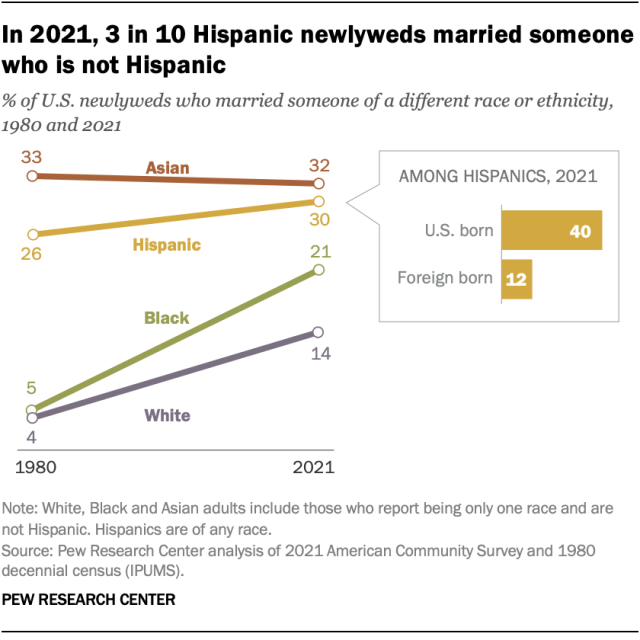
Views of Hispanic identity may change in the coming decades as broad societal changes, such as rising intermarriage rates, produce an increasingly diverse and multiracial U.S. population.
In 2021, 30% of Hispanic newlyweds married someone who is not Hispanic. The Hispanic intermarriage rate is similar to the rate for Asians (32%) but higher than the rate for Black (21%) and White (14%) newlyweds. Among Hispanic newlyweds, 40% of those born in the U.S. married someone who is not Hispanic, compared with 12% of immigrant newlyweds, according to an analysis of ACS data.
Among all married Hispanics in 2021, 21% had a spouse who is not Hispanic.
Our 2015 survey found that 15% of U.S. Hispanic adults had at least one parent who is not Hispanic. This share rose to 29% among the U.S. born and 48% among the third or higher generation – those born in the U.S. to parents who were also U.S. born.
What role does skin color play in whether someone is Hispanic?
As with race, Latinos can have many different skin tones. A 2021 survey of Latino adults showed respondents a palette of 10 skin colors and asked them to choose which one most closely resembled their own.
Latinos reported having a variety of skin tones, reflecting the diversity within the group. Eight-in-ten Latinos selected one of the four lightest skin colors, and the second-lightest was most common (28%), followed by the third- (21%) and fourth-lightest colors (17%). By contrast, only 3% selected one of the four darkest skin colors.
A majority of Latino adults (57%) say skin color shapes their daily life experiences at least somewhat. Similar shares also say having a darker skin color hurts Latinos’ ability to get ahead in the U.S. (62%) and having a lighter skin color helps Latinos get ahead (59%).
Are Afro-Latinos Hispanic?
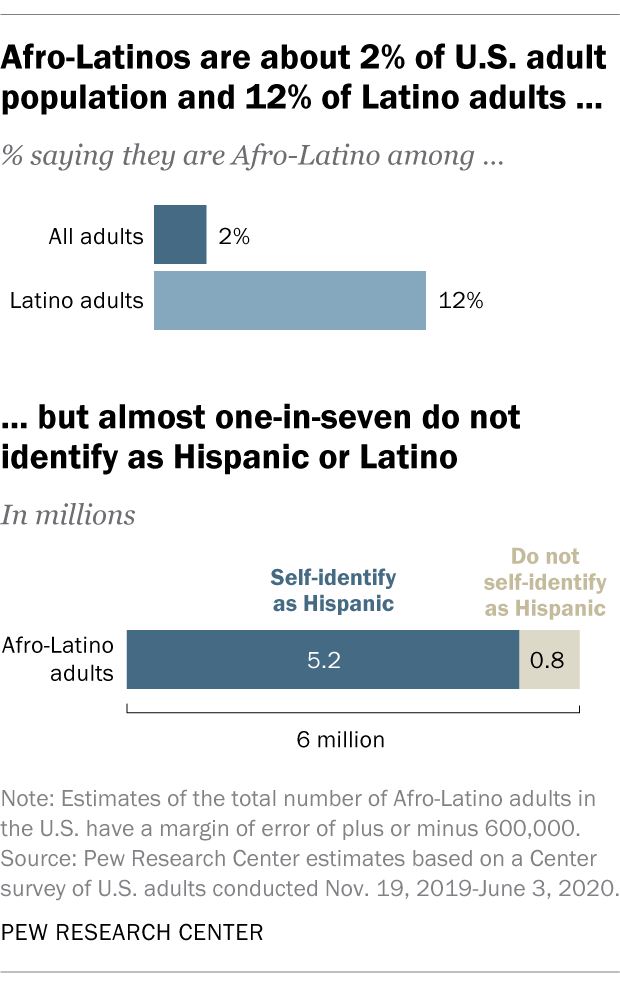
Afro-Latino identity is distinct from and can exist alongside a person’s Hispanic identity. Afro-Latinos’ life experiences are shaped by race, skin tone and other factors in ways that differ from other Hispanics. While most Afro-Latinos identify as Hispanic or Latino, not all do, according to our estimates based on a survey of U.S. adults conducted in 2019 and 2020.
In 2020, about 6 million Afro-Latino adults lived in the U.S., making up about 2% of the U.S. adult population and 12% of the adult Latino population. About one-in-seven Afro-Latinos – an estimated 800,000 adults – do not identify as Hispanic.
Does country of origin or ancestry affect whether someone is Hispanic?
Similar to race and skin color, Hispanics can be of any country of origin or ancestry. However, people from certain countries may be more likely to identify as Hispanic on census forms. For example, in a Center analysis of the 2021 ACS, nearly all immigrants from several Latin American and Caribbean countries called themselves Hispanic. That included nearly 100% of those from Mexico, Cuba and El Salvador among many others; 97% of those from Venezuela; 94% from Chile; 93% from Spain; 92% from Argentina; and 88% from Panama.
Are Brazilians, Portuguese, Belizeans and Filipinos considered Hispanic?
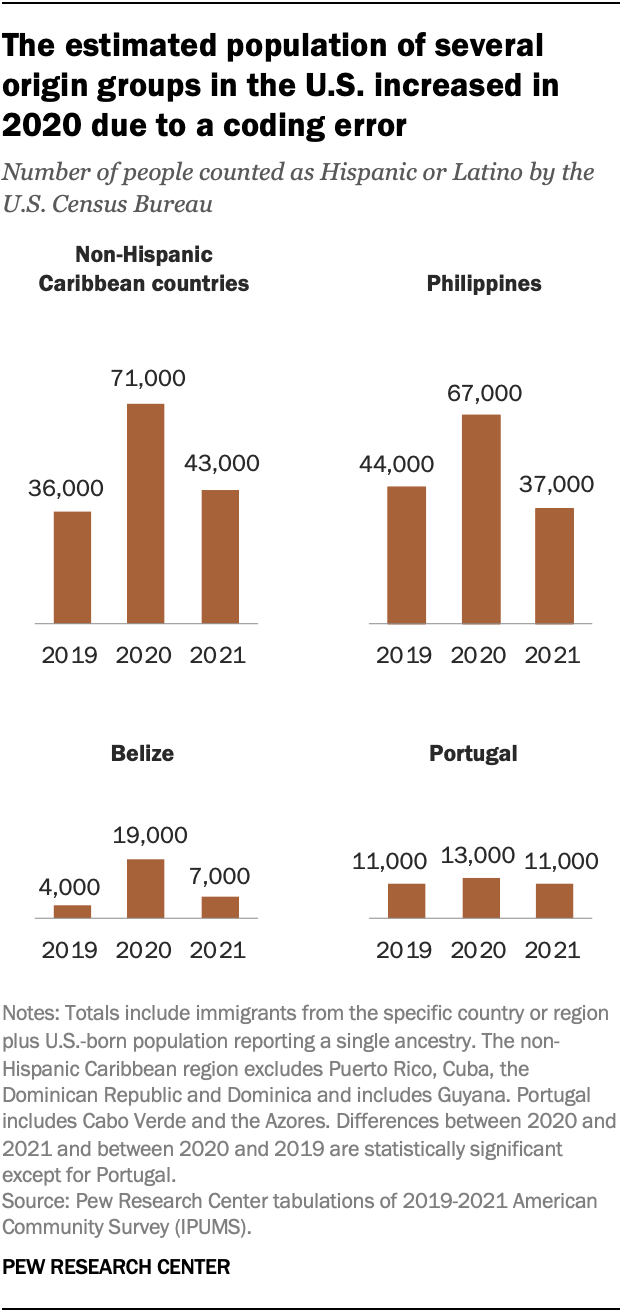
Officially, Brazilians are not considered Hispanic or Latino because the federal government’s definition – last revised in 1997 – applies only to those of “Spanish culture or origin.” In most cases, people who report their Hispanic or Latino ethnicity as Brazilian in Census Bureau surveys are later recategorized – or “back coded” – as not Hispanic or Latino. The same is true for people with origins in Belize, the Philippines and Portugal.
However, an error in how the Census Bureau processed data from a 2020 national survey omitted some of the coding and provides a rare window into how Brazilians living in the U.S. view their identity.
In 2020, at least 416,000 Brazilians — more than two-thirds of Brazilians in the U.S. — described themselves as Hispanic or Latino on the ACS and were mistakenly counted that way. Only 14,000 Brazilians were counted as Hispanic in 2019, and 16,000 were in 2021.
In addition, 30,000 more people with Filipino origin were counted as Hispanic or Latino in 2020 than in 2021. The number with origins in non-Hispanic Caribbean countries – including Haiti, Jamaica, Guyana and the Virgin Islands – was 28,000 higher. The number from Belize was almost 12,000 higher than in 2021, but the number with Portuguese origin was similar to other recent years.
The increase in the Hispanic population among Brazilians in 2020 was far higher than for the other groups because 70% of Brazilians considered themselves to be Hispanic or Latino – compared with 41% of Belizeans, 3% of Filipinos and 3% of those of non-Hispanic Caribbean origin.
How many people with Hispanic ancestry do not identify as Hispanic?
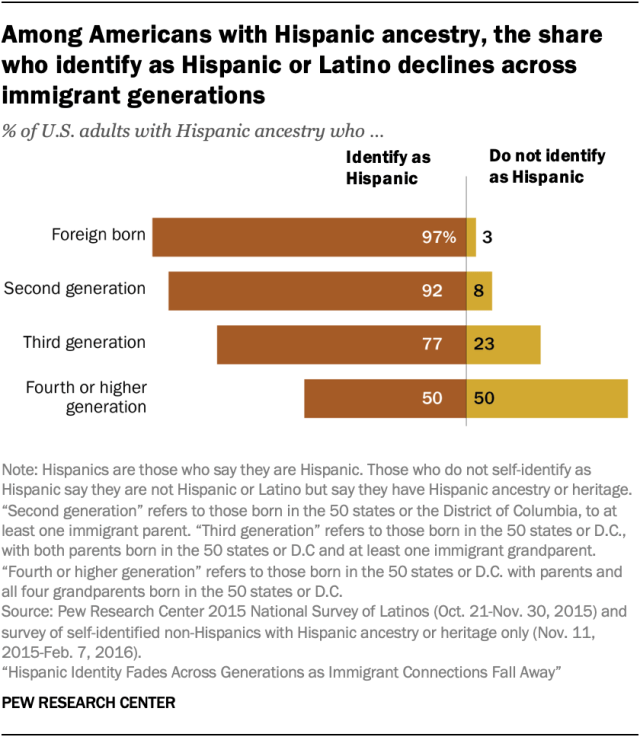
Of the 42.7 million adults with Hispanic ancestry living in the U.S. in 2015, an estimated 5 million people, or 11%, said they do not identify as Hispanic or Latino, according to a Center survey. These people aren’t counted as Hispanic in our surveys.
Notably, Hispanic self-identification varies across immigrant generations. Among immigrants from Latin America, nearly all identify as Hispanic. But by the fourth generation, only half of people with Hispanic heritage in the U.S. identify as Hispanic.
How has the Census Bureau changed the way it counts Hispanics over time?
The Census Bureau first asked everybody in the country about Hispanic ethnicity in 1980, but it made some efforts before then to count people who today would be considered Hispanic. In the 1930 census, for example, the race question had a category for “Mexican.”
The first major attempt to estimate the size of the nation’s Hispanic population came in 1970 and prompted widespread concerns among Hispanic organizations about an undercount. A portion of the U.S. population (5%) was asked if their origin or descent was from the following categories: “Mexican, Puerto Rican, Cuban, Central or South American, Other Spanish” or “No, none of these.”
This approach indeed undercounted about 1 million Hispanics. Many second-generation Hispanics did not select one of the Hispanic groups because the question did not include terms like “Mexican American.” The question wording also resulted in hundreds of thousands of people living in the Southern or Central regions of the U.S. being mistakenly included in the “Central or South American” category.
By 1980, the current approach – in which someone is asked if they are Hispanic – had taken hold, with some changes to the question and response categories since then. In 2000, for example, the term “Latino” was added to make the question read, “Is this person Spanish/Hispanic/Latino?”
Note: This post was originally published on May 28, 2009, by Jeffrey S. Passel and Paul Taylor, former vice president of Pew Research Center. It has been updated a number of times since then.


